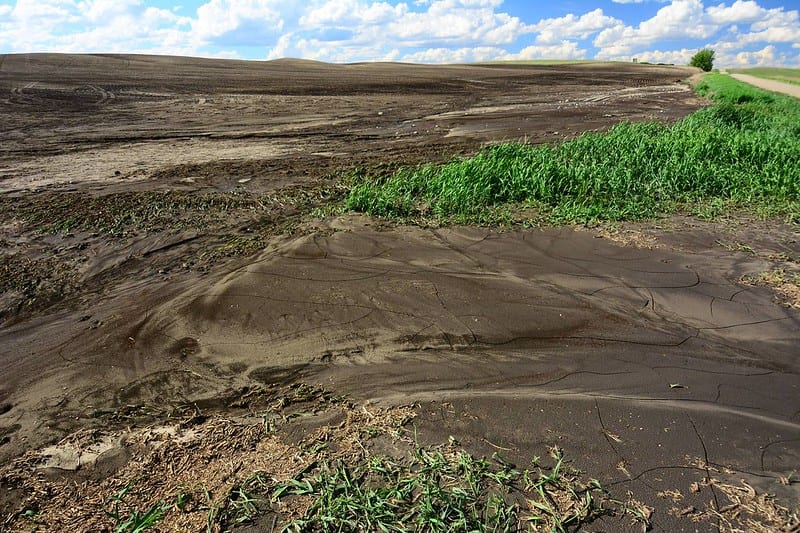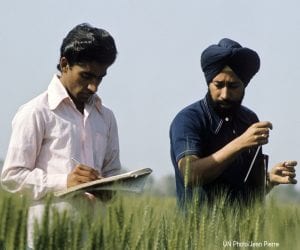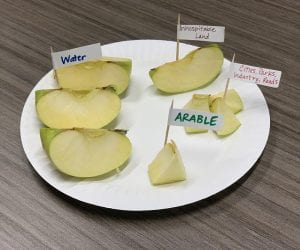The following background reading was provided to middle and high school students who were participating in the 2017-2018 World of 7 Billion student video contest. The reading was updated Fall 2020.
One of the greatest challenges facing our growing population is how we will feed an expected 9.7 billion people by the middle of this century. As our global family expands by nearly 25 percent in 30 years, experts expect we will need to increase our food production at historical rates. This would be to accommodate both the growing number of people and their changing diets across the globe. At the same time, climate change is beginning to affect every aspect of food production, creating a lot of uncertainty about the world’s ability to meet future food needs.
Listed below are just a few of the many ways human population growth is related to food security and feeding 10 billion people.
Hunger’s Far-Reaching Consequences
Hunger and malnutrition affect people all over the world. Globally, 1 in 9 individuals are undernourished. Geopolitical conflict, severe weather, and inadequate infrastructure for storing and transporting food in developing countries leads to hunger and even famine. In developed nations, food deserts (areas where there is little to no access to full-service markets or groceries) threaten the health and nutrition of some communities. Wherever it is found, hunger affects physical and mental health, leading to lower performance in school or work. This can limit development and prosperity in a nation or community, and inhibit progress in other areas such as education, public health, and social equality.
The Problem with Food Waste
According to the U.N. Environment Program, roughly one-third of food grown globally is lost as waste. In less developed countries, this is mainly due to a lack of adequate storage to keep the food fresh before it gets to the consumers. In more developed countries, food waste mostly occurs at the home and retail (grocery stores, restaurants and other food services) level. Food waste can also effect the global climate: unconsumed food is the largest component of solid waste in landfills in the U.S., contributing significantly to methane emissions.
Food’s Resource and Energy Use
Globally, agriculture uses incredible amounts of natural resources and energy.
Water: About 70 percent of freshwater withdrawals are for agriculture, and much of that water is being used faster than it can be replenished. As a means of increasing the water supply, the farming industry is increasingly turning to desalinized seawater for crop irrigation. However, this alternative water source is not without cost. Desalination plants tend to be expensive, have high carbon footprints, and release pollutants that threaten the health of the marine environment.

Land: Unsustainable farming practices cause erosion and exhaust soil nutrients, degrading once productive and fertile lands to the point that they can no longer grow crops. The practice of growing one type of crop across a large area of land, for example, degrades soil and contributes to biodiversity loss. Our diets also play a part because people in both developing and developed nations are eating more animal-based foods and raising animals is resource intensive.
Energy: Industrial agriculture is increasingly reliant on energy from fossil fuels for equipment, processing, transportation and fertilizer production. Overall, agricultural production accounts for 30% of the world’s energy use.
Agriculture is the Main Driver of Deforestation
An estimated 46,000-58,000 square miles of forest are lost globally each year, and agriculture is the main driver. Trees are cut down to clear land for planting crops or grazing cattle, and harvested for paper and other products. The demand for a few commodities in particular, like soybeans, palm oil and beef, spurs a disproportionate amount of this deforestation. Deforestation threatens biodiversity by destroying animal and plant habitats and resources provided by trees and forests. Tropical rainforests, which cover only 6% of Earth’s surface area, house more than half of plant and animal species. Additional eco- services provided by trees are also lost when they are cut, especially preventing widespread erosion and storing carbon.
Pollution from Agriculture
Agriculture pollutes our environment on the local and the global scale. Crop and livestock production contribute more than one-third of global greenhouse gas emissions through energy use and the methane that livestock emit through their normal digestive processes. Certain agricultural practices, such as the overuse of pesticides and fertilizers, directly pollute the soil and water, as does the runoff from animal waste.
Image credits: Prairie (Erosion by USFWS Mountain-Prairie is licensed under CC BY 2.0); Squash (20130920-OC-LSC-0073 by US Department of Agriculture is licensed under CC BY 2.0)





